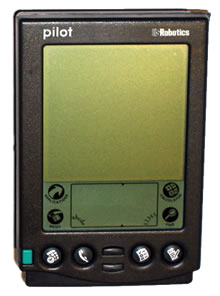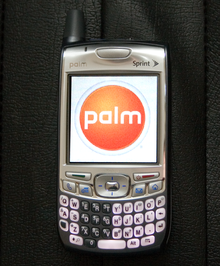Palm (PDA): Difference between revisions
No edit summary |
|||
| Line 181: | Line 181: | ||
==External links== |
==External links== |
||
* |
*[http://www.palm.com/ Palm.com] |
||
*[http://siliconuser.com/?q=node/17 Early History of Palm (Part I)] |
|||
[[Category:Electronics companies]] |
[[Category:Electronics companies]] |
||
[[Category:Palm OS devices]] |
[[Category:Palm OS devices]] |
||
Revision as of 13:58, 22 October 2007
Palm devices are Personal Digital Assistants (PDAs) which run Palm OS. This page describes the range of Palm devices, from the first generation of Palm machines known as the Pilot through to the latest models currently produced by Palm, Inc..
 |
 |
 |
 |
 |
 |
 |
History
Pilot was the name of the first generation of personal digital assistants manufactured by Palm Computing in 1996 (then a division of U.S. Robotics).
The first two generations of PDAs from Palm were referred to as "PalmPilots". Due to a trademark infringement lawsuit brought by the Pilot Pen Corporation, since 1998 [1] handheld devices from Palm have been known as Palm Connected Organizers or more commonly as "Palms". "PalmPilot" has entered the vernacular as a synonym for PDAs, regardless of the brand.
The inventors of the Pilot were Jeff Hawkins, Donna Dubinsky, and Ed Colligan, who founded Palm Computing. The original purpose of this company was to create handwriting recognition software for other devices, named Graffiti, but their research convinced them they could create better hardware as well. Before starting development of the Pilot, Hawkins is said to have carried a block of wood, the size of the potential pilot, in his pocket for a week. Palm was widely perceived to have benefited from the notable if ill-fated earlier attempts to create a popular handheld computing platform by Go Corporation and Apple Computer.
The first Palms, the Pilot 1000 and Pilot 5000, had no infrared port, backlight, or flash memory, but did have a serial communications port. Their RAM size was 128 kB and 512 kB respectively, and they used version 1 of Palm OS. Later, it became possible to upgrade the Pilot 1000 or 5000's internals to up to 1 MB of internal RAM. This was done with the purchase of an upgrade module sold by Palm, and the replacement of some internal hardware components. Originally, it was conceived that all Palm PDAs were to be hardware-upgradeable to an extent, but ultimately, this capability gave way to external memory slots and firmware-upgradeable flash memory after the Palm III series.
The next couple of Palms, called PalmPilot Personal and PalmPilot Professional, had a backlight, but still no infrared port or flash memory. Their RAM size was 512 kB and 1024 kB respectively. They used the more advanced version 2 of the Palm OS.
Palm III, and all the following Palms, did not have the word "Pilot" in their name due to legal disputes. (Pilot was, and still is, a registered trademark for pens.) Palm III had an IR port, backlight, and flash memory. The latter allowed to upgrade Palm OS, or, with some external applications, to store programs or data in flash memory. It ran on two standard AAA batteries. It was able to retain enough energy for 10-15 minutes to prevent data erasure during battery replacement. It had 2 Megabytes of memory, large at the time, and used Palm OS 3. (Palm also produced an upgrade card for the Pilot series, which made them functionally equivalent to a Palm III.)
Meanwhile, with Palm Computing now a subsidiary of 3Com, the founders felt they had insufficient control over the development of the Palm product. As a result, they left 3Com and founded Handspring in June 1998. When they left Palm, Hawkins secured a license for the Palm OS for Handspring, and the company became the first Palm OS licensee. Handspring went on to produce the Handspring Visor, a clone of the Palm handhelds that included a hardware expansion slot (early Palm devices also had a hardware expansion slot, however this was for device upgrade purposes, not peripherals) and used slightly modified software.
The next versions of Palm used Palm OS 3.1. These included Palm IIIx with 4 Megabytes of memory, Palm IIIe without flash memory or hardware expansion slot (and available for cheaper price), Palm V with 2 Megabytes of memory, and Palm Vx with 8 Megabytes of memory.
Palm VII had wireless connection to some Internet services, but this connection worked only within USA. It used Palm OS 3.2.
Palm IIIc was the first Palm handheld with color screen. It used Palm OS 3.5 which provided extensive tools for writing color applications.
Some of these newer handhelds, for example Palm V, used internal rechargeable batteries. Later this feature became standard for all Palms.
Palm handhelds initially ran on the popular DragonBall processors, a Motorola 68000 derivate. More recent models are using a variation of the popular ARM architecture (usually referred to by the Intel Xscale brand name). This is a class of RISC microprocessors that is widely used in mobile devices and embedded systems, and its design was influenced strongly by a popular 1970s/1980s CPU, the MOS Technology 6502.
Palm Computing was spun off into its own company (called Palm Incorporated) in 2000. Handspring later merged with Palm to form palmOne in 2003 when Palm Inc. split into companies based upon selling hardware (palmOne) and the software (PalmSource). In 2005, palmOne acquired the full rights to the Palm name by purchasing the shared rights PalmSource owned and changed names back to Palm again. PalmSource was acquired by ACCESS Systems in 2005, which subsequently sold the Palm OS source code back to Palm, Inc. in December, 2006.
Palm handhelds continue to advance, including the ability to become hard drives on computers via USB cables, and are beginning to merge with smartphones. The "Treo 700w" is one of the latest offering that combines a Palm handheld with mobile phone, e-mail, SMS, and instant messaging. It is the first Palm device to use Windows Mobile instead of Palm OS. It is widely expected that Palm handhelds as a PDA-only device will disappear as multi-function Palm handhelds like the Treo 650 decline in price. Multi function devices include several different abilities in the same package such as: an MP3 player, a camera, Wi-Fi, Bluetooth, or several other options. The Treo 650+ series is a multi-functioning series, packing in a camera,MP3,Bluetooth,and a phone. The Zire 71 and 72 are examples of this also.
Palm's newest offering, the "Foleo" was cancelled before ever becoming publicly available.
List of PDA models
Current models
Handhelds
Treo Smartphones
Other Smartphones
Discontinued models
The following PDAs are no longer in production.
| Discontinued Model | Replacement model |
| Pilot 1000 | PalmPilot Personal |
| Pilot 5000 | Palm Pilot Professional |
| PalmPilot Personal | Palm III |
| PalmPilot Professional | Palm IIIx |
| Palm III | m100 |
| Palm IIIe | m100 |
| Palm IIIx | m105 |
| Palm IIIxe | m125 |
| Palm IIIc | m130 |
| Handspring Visor | Zire 31 |
| Palm V | Palm m500 |
| Palm Vx | m500 |
| Palm VII | VIIx |
| Palm VIIx | i705 |
| Palm m100 | m105 |
| Palm m105 | Zire |
| Palm m125 | Zire 31 |
| Palm m130 | Zire 71 |
| Palm m500 | Tungsten E2 |
| Palm m505 | m515 |
| Palm m515 | Tungsten E2 |
| Palm i705 | Treo 650 |
| Tungsten E | Tungsten E2 |
| Tungsten T | Tungsten T2 |
| Tungsten T2 | Tungsten T3 |
| Tungsten T3 | Tungsten T5 |
| Tungsten T5 | TX |
| Tungsten W | Treo 600 |
| Tungsten C | TX |
| Zire | Zire 21 |
| Zire 21 | Zire 31 |
| Zire 31 | Z22 |
| Zire 71 | Zire 72 |
| Zire 72 | none |
| Handspring Treo 90 | Treo 180 |
| Handspring Treo 180 | Treo 270 |
| Handspring Treo 180g | Treo 270 |
| Handspring Treo 270 | Treo 300 |
| Handspring Treo 300 | Treo 600 |
| Treo 600 | Treo 650 |
| Treo 650 | Treo 680, Treo 700p, Treo 755p |
| LifeDrive | none |
Security
When using Palm devices in secure environments there are three primary concerns:
- Data on the Palm can be retrieved if the Palm is lost or stolen.
- The synchronization mechanism may be used to infect the host PC and lead to data leakage.
- Password-protected private records synchronized to a PC can be stolen even when using extra security such as disk encryption.
- See Security analysis by Innersafe Corporation
- See Flash video demo of password bypass exposing private records on PC
See also
- Palm OS - includes discussion and links to Palm OS - compatible and Palm OS
- List of Palm OS Devices
- PalmSource, Inc.
- Palm, Inc.
